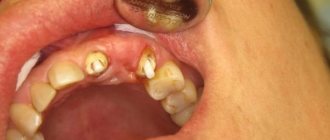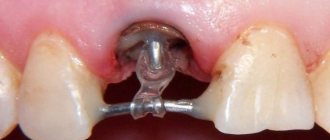Features Indications Contraindications Materials and manufacturers Installation Possible complications Timing What to do in case of loss Care after surgery Care after surgery
Implant prosthetics is the most physiological way to restore missing teeth. The essence of the method is that an artificial tooth root is implanted into the gum, on top of which an orthopedic structure (crown, bridge) is installed. But in order for the prosthetic system to look natural, fit tightly to the gum, and be firmly fixed to the implant, special superstructures are used - a gum former and an abutment.
The gum former is not always installed during implantation. In case of complete edentia of the jaw, when one-stage technologies with immediate loading of the prosthesis are used to restore the dentition, it is not used. Installation of this superstructure is necessary in a two-stage protocol. Without it, it is impossible to achieve the correct gingival contour so that the prosthesis looks natural and aesthetically pleasing.
With one-stage techniques, the stage with the installation of this element is often skipped. In these cases, one-component implants are usually used, which are immediately loaded with a prosthesis. If two-component models are used, and the installation of a temporary prosthesis is performed on day 3
, the implantologist sometimes installs a superstructure to preserve the gingival margin.
This is especially true when it comes to restoring front teeth.
. Here, attention is paid more to aesthetics, and achieving a beautiful smile without using this superstructure is almost impossible.
What it is?
The gum former is a miniature titanium cylinder with a screw stem, identical in size to the future abutment. Thanks to the fine threads, the superstructure is securely attached to the implant. After installing the gum former, soft tissue begins to grow around it, forming an even, beautiful contour.
The former is often confused with the abutment. In fact, the functions of these elements are different:
- An abutment
is an adapter between the root part of the implant and the prosthesis. It is needed for reliable fastening of the orthopedic structure to the titanium root; it is installed after the formative superstructure has completed its task of restoring the anatomical shape of the gums. - A former
is a temporary structure that is used to create a regular, even gingival contour around the implant.
The element can be installed immediately
after implantation of the implant into the jawbone, or
3-6 months
after surgery (when the artificial root fuses with the bone tissue).
Differences from abutment
Some patients confuse the healing abutment with the abutment. It can actually be used in implant placement to expand gums in a one-step procedure where a temporary crown and temporary abutment are placed. But this is not its main purpose.
The healing abutment is always installed temporarily. It is used to create a natural depression for further installation of an abutment and adjusting the shape of the gums for a permanent crown.
The abutment is designed to fix the crown. It screws into a titanium rod.
Indications for installation
The jaw bone in the area of the missing tooth ceases to receive the necessary load and gradually begins to dissolve. Periodontal tissues lose their elasticity and sag. Subsidence of soft tissues is a direct indication for the use of a forming component. The element prepares the gums for the installation of a prosthesis.
A periodontal ridge is formed around the part, which further stabilizes the implant during the period of its osseointegration. The doctor keeps the process of soft tissue growth under control by determining the time for removing the former and installing the abutment.
A common reason for implant failure is ignoring doctor’s recommendations.
Failure to follow recommendations and lack of proper care is the most common cause of complications in the postoperative period and implant loss.
Factors provoking undesirable consequences:
- Smoking, drinking alcoholic beverages and drugs;
- Lack of proper nutrition;
- Not using preventive medications;
- Eating food at different temperatures immediately after installation of the prosthesis;
- Lack of proper oral hygiene;
- Lack of regular visits to the dentist's office;
- Uncontrolled use of medications.
The most dangerous complication is viral infection of the tissues around the installed implant - reimplantitis.
Materials and manufacturers
In the manufacture of implantation systems and auxiliary products, medical titanium, stainless steel, and other metal alloys are used. For installation in the frontal zone, there are models made of zirconium that are not visible through the gum tissue. Manufacturers offer different models of shapers. The doctor selects an option according to the clinical situation. The classification is based on the shape, size and type of part. The line includes standard, narrow, and wide models.
Standard ones are used in cases involving a translingual method of intervention, when correction of the mucous membrane is carried out immediately before installation of the implant. Markers are applied to the surface of the element, allowing you to control the level of fouling of soft tissue. If the diameter of the prosthetic structure is more than 5 mm, wide models are used, if less than 5 mm, narrow models are used.
The most famous manufacturers of implantation systems and components for them:
- NSK (Japan)
- Nobel Biocare (USA)
- Astra Tesh (Sweden)
- Trate AG (Switzerland)
- Bicon (USA)
- Niro (Germany)
- Semantos (Germany)
- Impro (Germany)
- Adin (Israel)
- Alpha Bio (Israel)
- NeoBiotech (South Korea)
Of course, the list is not limited to the brands listed. The cost of placing a gum former depends on the material, brand, technical parameters, and size of the superstructure. For good results, it is recommended to install implants and auxiliary components from the same manufacturer.
The network of RUTT clinics in Moscow uses Swiss implantation systems and ROOTT superstructures produced by Trate AG. All components are made of the same grade of titanium and fit perfectly due to their exact size. This is a universal, reliable implantation system, the effectiveness of which is scientifically proven.
Symptoms of implant rejection
The first signs of reimplantitis:
- Pain;
- Swelling;
- Bleeding;
- Feeling of discomfort.
If you don’t see a dentist with these signs, the situation will get worse. The following symptoms will be added:
- Implant mobility;
- Growing pain;
- Bad breath;
- Pus appears in the area of the operation;
- Body temperature rises.
- The gum cuff changes due to the inflammatory process.
How to place a gum former
Thanks to the thread, the implantologist simply screws the forming cylinder into the artificial root. The stages of installation of formers on implants depend on the protocol used.
Installation of the forming component using the two-step method
- the structure is installed 3 (on the lower jaw) or 6 (on the upper) months after implantation;
- the doctor makes a small incision in the area of the implant, removes the plug, and screws in the gum former instead;
- after 2-3 weeks (time for proper tissue growth), the element is removed. Instead, an abutment is screwed in, onto which the prosthesis made from the cast is fixed.
How to install a gum former after implantation using one-stage technologies
The procedure takes one stage - the doctor uses a minimally invasive method to implant an implant with an abutment, onto which an adaptive orthopedic system is fixed immediately or after 2-3 days. Soft tissues grow around the artificial root. Implantologists believe that with one-stage implantation, it is possible to do without a former, since the aesthetics of the gingival contour are completely preserved.
If the doctor did everything correctly and the patient carefully follows the recommendations regarding care, no complications will arise.
Recommendations for postoperative care
- avoid solid foods for a week after the intervention;
- refrain from eating too hot or cold foods;
- rinse your mouth with antiseptics and herbal decoctions recommended by the implantologist;
- take medications prescribed by a doctor;
- Stop smoking until the tissues have completely healed.
Is it possible to replace a lost dental implant?
If complications have become irreversible and it is not possible to save the prosthesis, the question of reimplantation arises. It includes:
- removal of the implant (if it has not completely fallen out);
- elimination of inflammation, disinfection of the wound channel, removal of pus (if necessary);
- rehabilitation period;
- taking medications;
- sinus lift (if necessary) - bone tissue augmentation;
- installation of a new implant.
The interval between the moment when a dental implant falls out and reimplantation is several months. At this time, the patient must carefully monitor the condition of the oral cavity, regularly perform all hygiene procedures, rinse with a medical solution and strictly follow all the recommendations of the dental surgeon.
According to statistics, the percentage of implant rejection is extremely small - only 1-5%, depending on the manufacturer, and the majority of them are due to the fault of the patients themselves, who violate the rules of the rehabilitation period. In general, implants take root quickly and delight their owners with a beautiful smile for many years.
Possible complications
The most common complaint after installation of a superstructure is pain in the gums
. During the first 2 days after the intervention, the pain goes away. If pain persists for more than a week after installing a gum former, and its intensity increases, you should immediately consult a doctor. Possible causes of pain:
- the doctor overtightened the component, which led to compression of the soft tissue or damage to the bone;
- gums hurt after installing a gum former due to poor hygiene, which caused an inflammatory process;
- the structure is installed below the mucosa;
- The element size is incorrectly selected.
The latter situations arise due to incorrect selection of the model in height. You can avoid complications by contacting an experienced doctor and following the recommendations regarding postoperative oral care.
Impact of the shaper
A rubber connection with a cylindrical head makes up the design of the gum former, which is made of titanium. The thread is used for fixation on the implant. The cylindrical head creates a natural depression in the gum to restore its shape. This ensures a tight fit of the crown to the mucosa.
The orthopedic dentist selects a gum former for the patient according to individual parameters. This is possible thanks to a wide selection of shapes and sizes of such structures in the range of manufacturers of implant systems. You can select a former that is suitable for installation in case of implantation carried out in one or two stages.
What to do if the shaper falls out
Sometimes it happens that the element gets twisted and falls out of the implant. A correctly installed element protrudes above the mucous membrane by only 1.5-2 mm. The main cause of superstructure failure is inappropriate torque force or increased bone looseness, which causes the component to become loose and not hold in the implant. If the gum former falls out of the implant, you should immediately consult a doctor. Its long-term absence will lead to overgrowth of the hole, and the mucous membrane will need to be opened again.
Author of the article Voznyuk Vladimir Aleksandrovich Maxillofacial surgeon-implantologist of the highest category
Experience more than 30 years
Diagnosis and treatment
To determine why the implant twists or falls out of the gums, it is necessary to undergo a comprehensive diagnosis. It includes:
- visual examination in the dentist's chair,
- radiography,
- bacteriological analysis of a smear from the oral mucosa.
The specialist will determine the negative factor and tell you whether the implant can be saved or whether a repeat operation is necessary. The structure can be saved if the implant has not become loose and the bone tissue has not lost volume. In other cases, reimplantation is usually indicated.
Anesthesia
If there is constant pain at the site where the former is installed, you need to do a gentle massage of the gums with tea tree essential oils, which help relieve pain.
A mixture of table salt (fine) and honey relieves pain well. For one part of salt, take 4 parts of liquid honey.
Baths made from infusion of calendula or echinacea flowers are good for pain relief. You should not rinse your mouth, but simply keep the liquid in your mouth and spit. The decoction should be used warm; you should not rinse your mouth with hot liquid - this will cause bleeding. A decoction of echinacea or calendula prevents the development of inflammatory processes.
When can you get prosthetics?
The final stage of prosthetics occurs after complete healing of the gums around the former, i.e. in 1-4 weeks. The patient should not be bothered by pain, swelling or bleeding. If the tissue has recovered sufficiently, the final stage of implantation begins. At the preliminary appointment, the implantologist takes impressions of the jaws, which will help the specialist make a crown. The patient may also be referred for an orthopantomogram (OPTG) to see how the osseointegration of the metal implant is progressing. At the last stage, the former is unscrewed, an abutment is installed into the implant, and the final element is the crown.
Oral care
You don't have to do anything special. After implantation, handle your gums carefully and do not injure them. While the former is in place, chew on the other side and do not eat hard foods. Use a soft toothbrush to brush your teeth. After each meal, rinse your mouth with a solution of sea salt, diluted according to the instructions with calendula tincture or sage essential oil (5 drops per glass of boiled water). If you experience any unpleasant or unfamiliar sensations, contact your dentist immediately.
High-quality dental implantation in Novosibirsk is carried out by experienced doctors at the Dentistry 24 clinic.
Bottom line
Implantation and prosthetics are a complex process that requires a highly qualified orthopedic dentist. With a long-term absence of a tooth, the bone tissue decreases in volume, and the gum tissue sags. For successful implantation, you need the correct gum contour, a formed socket for the artificial tooth and a sufficient amount of bone mass.
The healing abutment provides the necessary configuration for successful implantation. Externally, the temporary abutment is a thick screw with a cap that matches the size of the future artificial tooth crown. It is installed on a pre-implanted and osseointegrated artificial root of the future tooth.
After correcting the contour of the gingival margin, the temporary abutment is removed and a permanent structure is installed in its place.
Sources used:
- Robustova T. G.
Dental implantation: surgical aspects. - M.: Medicine, 2003. - Lee, S. L. (2007). Applications of orthodontic mini implants
. Hanover Park, IL: Quintessence Publishing Co, Inc. - Orthopedic treatment based on dental implants / Karl E. Misch. — M.: Reed Elsiver
Classification
All gum formers are divided into three classes, depending on the type , shape and composition. These include:
- Premium They are made in Sweden and Switzerland. The main material is titanium.
- Business. Produced in Israel and Germany. The most commonly used are zirconium and titanium.
- Economy They are made in Korea or Israel from ceramics and plastic from zirconium.
6 effective methods for correcting deep bites
All products differ not only in composition, but also have a certain type of thread, shape and manufacturing technology.
When choosing a gum former, you should pay attention not only to its class and country of manufacture. Experts advise that all implants and other materials be supported by the same brand. Designs made in Israel are especially popular, as they have an affordable price and are distinguished by their quality.
Installation during pregnancy
Serious hormonal changes occur in the body of the expectant mother. Metabolism is being restructured, because Fetal nutrition is carried out at the expense of the resources of the mother's body. Against this background, the expectant mother’s immunity decreases, bones and teeth become more fragile. Therefore, dentists do not recommend dental implantation during pregnancy and lactation - so as not to burden the body and not harm the baby with medications.
However, a gum abutment is a more routine procedure. If you are faced with the fact that you had an implant installed before pregnancy and the need to fix the former fell just during this period, it is still worth postponing this stage until after the birth of the baby. After all, both the surgical intervention itself and the local anesthesia that is given during any treatment pose a rather great danger. In addition to the anesthetic, the injection may contain epinephrine (adrenaline), which is contraindicated for pregnant women. In exceptional cases, the installation of a former is allowed only in the second trimester of pregnancy and only with the permission of an obstetrician-gynecologist and dentist. But it is better to postpone this procedure until lactation is completed and the body is completely restored.
Author: Vasiliev A. A. (Thank you for your help in writing the article and the information provided)










